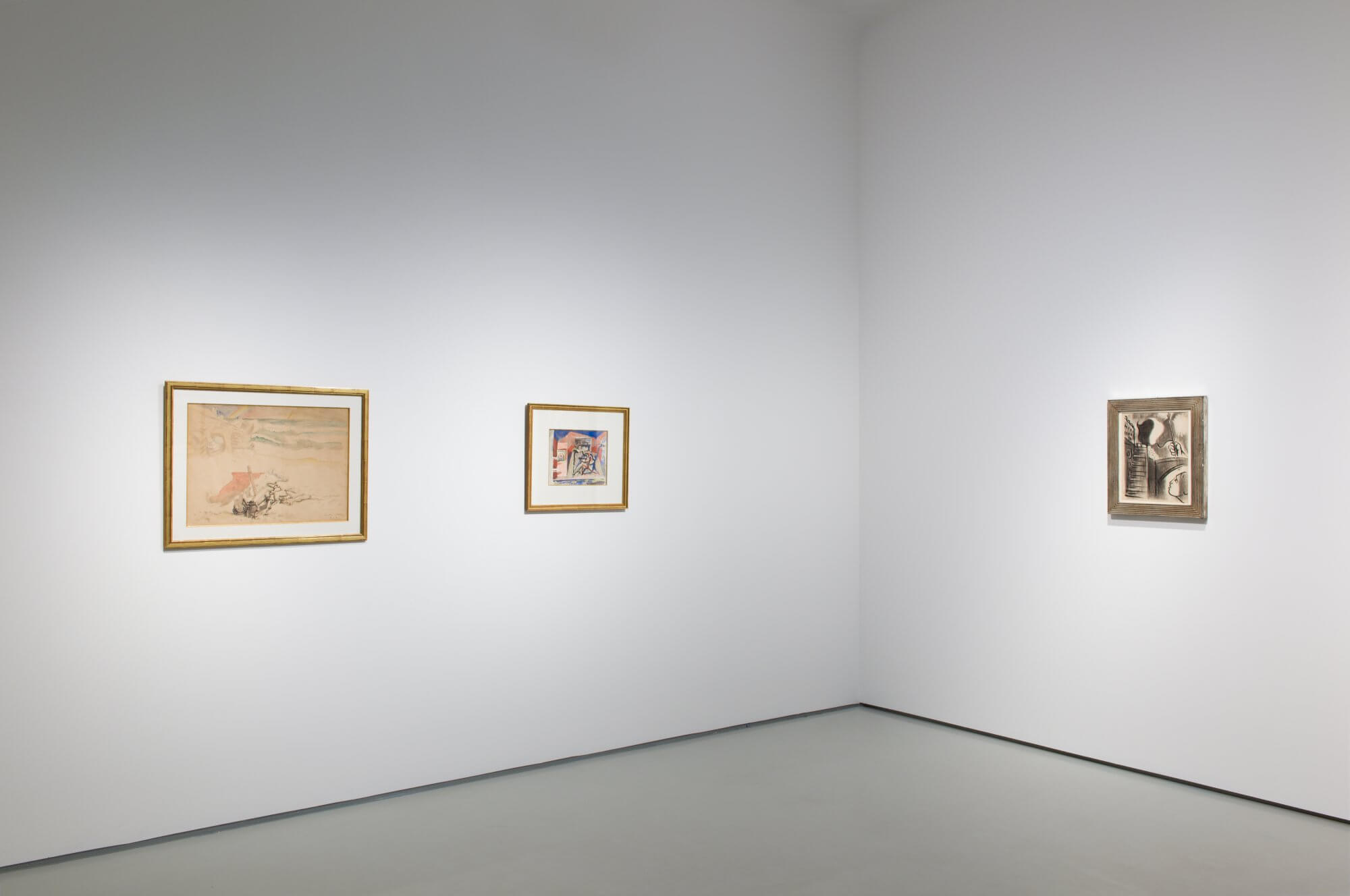André Masson
André Masson – La mémoire du monde
Sep 11th – Oct 18th, 2025
Opening:
Sep 11, 6 – 10 pm
LEVY Galerie, Berlin
ANDRÉ MASSON – THE MEMORY OF THE WORLD
André Masson (1896-1987) ranks among the pioneers of the Surrealist movement. Through his artistic language, he explored the boundaries of the subconscious, dreams and instincts with a depth and intensity that is virtually unparalleled. Masson, who explored new tecniques as a painter, was also a brilliant draftsman and created sculptures as well as stage sets. On top of that, he was an art critic, an insatiable reader with an encyclopedic education, a poet, a writer, and a connoisseur of both ancient mythology and Western and Far Eastern philosophy.
The beginning of Masson’s artistic career occurred during the aftermath of the First World War. The brutality and the turmoil that had shaken society also had a profound effect on the artist and are clearly reflected in his work. At the age of nineteen, he joined the military and personally witnessed the atrocities of the First World War. Most of his comrades were killed or wounded. In April 1917, Masson suffered a serious chest injury and was subsequently treated in various hospitals as well as in a psychiatric institution. He wrote: “It took many months before I managed to find myself again. My inner self had been completely devastated. Permanently.” These war traumas led several artists of his generation no longer to just dream of a revolutionary art, but to actively start creating one: Surrealism. By rejecting patriotism and the conventions of the academy, they initiated a revolution that was as poetic as it was political.
Towards the end of 1921, Masson moved into a studio in Paris, which became a regular meeting place for several artists, including Antonin Artaud, Michel Leiris, Georges Limbour, Joan Miró and, later, André Breton.
Within a few years, a whole group had formed around Breton, whose ambition was to combine poetry with political commitment. In the spirit of Karl Marx, they strove to change the world and, in the spirit of Arthur Rimbaud, also life itself.
Surrealism was officially founded on 15 October 1924 with the manifesto written by André Breton, starting with the following definition: “SURREALISM, n. Psychicautomatism in its pure state, by which one proposes to express – verbally, by means of the written word, or in any other manner – the actual functioning of thought. Dictated by the thought, in the absence of any control exercised by reason, exempt from any aesthetic or moral concern”. Their magazine, La Révolution Surréaliste, denounced bourgeois values, and in its headquarters hung a “mailbox of the collective unconscious”, in which ideas were gathered.
From 1922, a contract with art dealer Daniel-Henry Kahnweiler enabled Masson to devote himself entirely to his art. However, painting initially occupied a secondary role in Surrealism, which instead privileged poetry and less conventional artistic techniques such as collage and cadavre exquis.
Yet it was painting that caused the group’s first crisis. Breton strongly objected to the claim that there was no such thing as surrealist painting and responded by publishing the essay Surrealism and Painting in 1928. In it, he stated that the eye existed in a primordial state. He argued that the speed of automatism, both in writing and in draw-ing, overruled rational thought. Similarly to the primitive arts, surrealist art is like magic with an inner obsession. Following Breton’s theory, Masson developed a practical implementation of surrealist art. He let his hand glide freely over a sheet of paper, as if he were blind, and thus created unnamable figures, some of which were indefinable. Though he destroyed many of these sheets, he had ultimately invented his own form of automatism. While drawing proved to be the most suitable means to capture the rapidity of thought, the act of painting required too much preliminary work for such a spontaneous artistic expression. Masson eventually found a way around this problem by dripping glue onto the canvas and then scattering sand over it. This is how he created his first sand paintings, establishing him as one of the first gestural painters.
The Surrealists believed in the power of chance. They used it to not only create their works but also to help explain fate. It was chance that led to the sudden rush of love, or amour fou, which became their philosophy of life. One of their role models was the author Marquis de Sade, who used his sexually explicit writing to promote a radical erotic lib-eration. They indulged in fantasies of all kinds, and Masson proclaimed: “De Sade was like a shooting star. He confronted people with what they didn’t want to see. Until Freud came along. De Sade said:
Here! I’ll show you the depths of your existence, plunge you into it headfirst until you’re soaked to the skin and can no longer fool yourselves. You are the most brutal of all animals and always will be. Forever”. Through such works, the Surrealists strove to over-come social taboos and encourage a more liberal approach to sexuality.
In 1929, after Breton published the Second Surrealist Manifesto, the group split. He tried to un-equivocally define Surrealism as a revolutionary movement and demanded that all members un-questioningly support the Communist Party. Some of the original members, such as Aragon, Éluard, Ernst and Tanguy, stayed loyal to Breton, while others, including Masson, turned their backs on him.
Masson claimed: “Breton dragged us through the mud. We didn’t like that. So, at a meeting, we de-cided to answer him with a pamphlet”. The rebels gathered around Bataille and wrote a statement against Breton with the unambiguous title Un Cadavre.
After Hitler came to power in 1933 and in view of the increasing popularity of fascism in Italy, Breton and Bataille eventually reconciled. Along with others, they founded the Surrealist magazine Minotaure. The title was suggested by André Masson, one of the first artists of the 20th century to explore the myth of the Minotaur. The magazine, which was produced in an elaborate and luxurious manner, included works by artists such as Dalí, Ernst, Miró, Matisse and Picasso.
At the outbreak of the Spanish Civil War in July 1936, Masson and his family had already been living in Spain for two years, where he drew satirical illustra-tions for anarchist publications and designed flags for various international workers’ groups. During his time in Spain, he also painted a number of mesmer-ising, seemingly hallucinatory pieces. The Spanish landscape under the scorching sun inspired him to create series about farmers harvesting their crops, as well as pictures of insects dressed as matadors. He was particularly fascinated by the ceremonial dimen-sion and the aesthetics of the spectacle at bullfights, which he depicted in several works.
At the end of 1936, the Massons moved back to France. As the German troops began to gain ground there, they moved to Marseille, where a large num-ber of people were waiting to begin their journey into exile. The Massons managed to make the crossing to the United States in March 1941. Masson’s family settled in New Preston, Connecti-cut, where they made the acquaintance of Alexander Calder and Arshile Gorky.
In 1943, Masson and Breton had a final falling out, and in 1945, Masson broke all ties with the group of Surrealists. In August 1944, France was liberated from German occupation, and in October 1945, Mas-son and his family were able to return. Shortly before the end of the war, on 10 June 1944, the German SS perpetrated a brutal massacre in the village of Ora-dour-sur-Glane, where the entire population was murdered and the village completely destroyed. Mas-son felt compelled to deal with this and other atroci-ties of the Second World War in his work. He created ‘painted-monuments’ as a tribute to the resistance and the depth of the suffering endured.
The Massons ultimately settled in the south of France, more precisely in Le Tholonet near Aix-en-Provence, although the artist continued to main-tain a residence in Paris. He travelled extensively, for example to Italy, but the Provençal landscape awakened in him a new passion for the depiction of nature. Despite the atrocities of two world wars, his enthusiasm for German writers, philosophers and composers remained undiminished, and he intensified his contacts with Germany.
This exhibition presents the work of a truly unique artist who dedicated his life to the exploration of the unknown, the unconscious, and the freedom of the mind. Al-though Masson significantly influenced Surrealism, the self-proclaimed rebel of the movement never allowed himself to be confined to a single artistic style. For Masson, art was not a static condition, but a never-ending dialogue between the artist and the unknown. His art encourages us all to push the boundaries of our imagination and consciousness. It challenges us to discover hidden aspects of ourselves, to explore our instincts and our mystical side – in short, to delve into the memory of the world.
Dr. Roger Diederen

